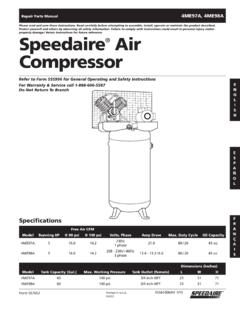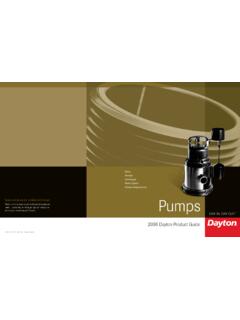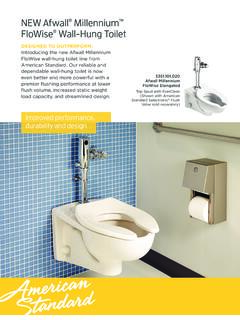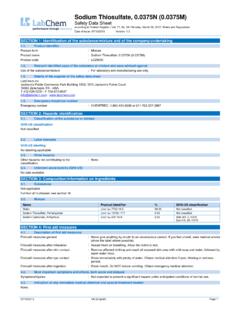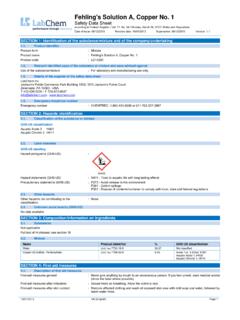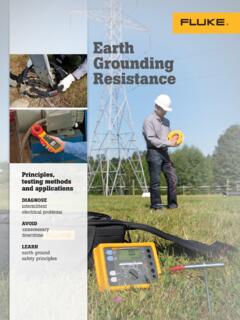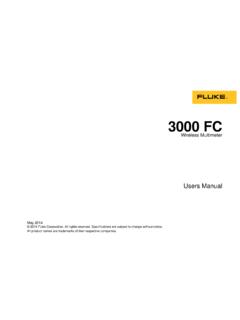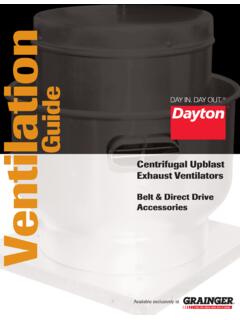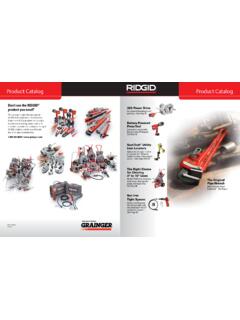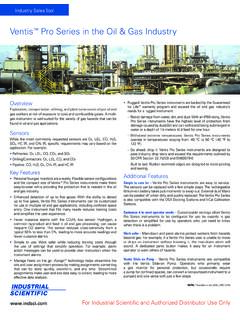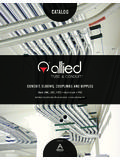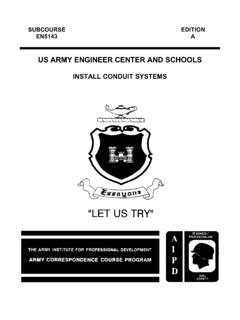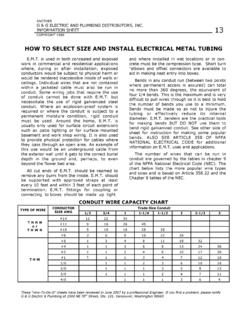Transcription of 1. Arrow 2. Rim Notch 3. Star-Point 4. Degree Scale 5. A ...
1 Bender GuideBender GuideFeaturesYour IDEALB ender has engineered features which be used with stub, offset and outer marks of saddle NotchLocates the center of a saddle the back of a 90 ScaleFor offsets, saddles and those special ChoiceHigh strength ductile iron or light weight conduit with skill and professionalism. Take the guess-work out of to RememberStep your you conduit using the recommended your bender s engineered : Reference to the above Steps 1, 2, and 3 will be madethroughout this above are features that lead to perfectly predictable and repeatable t Forget When bending on the floor, pin the conduit to the floor. Useheavy foot pressure. When bending in the air, exert pressure as close to your bodyas possible. In case you overbend, usethe back pusher or theexpanded end of the bender handle to straighten your conduit tofit the to Bend a StubThe stub is the most common bend. Note that your bender ismarked with the take-up of the arc of the bender :Consider making a 14 stub, using a 3/4 EMT IDEAL bender indicates stubs 6 to.
2 Simplysubtract the take-up, or 6 , from the finished stubheight. In this case 14 minus 6 = 8 .Step the conduit 8 from the up the Arrowon the bender with the mark on theconduit and bend to 90 .Remember: Heavy Foot pressure is critical to keep the EMT inthe bender groove and to prevent kinked to Make Back-To-Back BendsA back-to-back bend produces a U shape in a single length ofconduit. Use the same technique for a conduit run across the flooror ceiling which turns up or down a :Step the first 90 bend has been made, measure tothe point where the back of the second bend is to be, B .Step and mark your conduit the same distance,mark B .Step the mark on the conduit with the Star-Point onthe bender and bend to 90 .3 Star-Point on bender must be referenced for accurate to make an Offset BendThe offset bend is used when an obstruction requires a changein the conduit s making an offset bend, you must choose the most appro-priate angles for the offset.
3 Keep in mind that shallow bendsmake for easier wire pulling, steeper bends conserve must also consider that the conduit shrinks due to thedetour. Remember to ignore the shrink when working away fromthe obstruction, but be sure to consider it when working into :Step the distance from the last coupling to the shrink amount from the table on page 5 tothe measured distance and make your first second mark will be placed at the distancebetween bends. (Refer to table on page 5.)Step the Arrow with the first mark and using theDegree Scale bend to the chosen angle. Slide downthe conduit and rotate conduit 180 , align the Arrowand bend as offsets in the to keep your bodypressure close to the BendExample:30 Bend with a 6 Offset DepthDistance Between Bends 12 1-1/2 Shrink AmountReference Table for Offset BendsDegree of Bend22-1/2 30 45 60 52 5-1/4 3/8 3 7-3/4 9/16 6 3/4 4 10-1/2 3/4 8 1 5 13 15/16 10 1-1/4 7 1-7/8 6 15-1/2 1-1/8 12 1-1/2 8-1/2 2-1/4 7-1/4 3 7 18-1/4 1-5/16 14 1-3/4 9-3/4 2-5/8 8-3/8 3-1/2 8 20-3/4 1-1/2 16 2 11-1/4 3 9-5/8 4 9 23-1/2 1-3/4 18 2-1/4 12-1/2 3-3/8 10-7/8 4-1/2 10 26 1-7/8 20 2-1/2 14 3-3/4 12 5 Second BendStep 3.
4 (A)Align the center mark with theRim Notch and bend to 45 .(B)Do not remove the conduitfrom the bender. Slide thebender down to the next markand line up with the to 22-1/2 as indicated.(C)Remove and reverse theconduit and locate the otherremaining mark at the to 22-1/2 as :Step encounter a 3 pipe 4 feet from the last coupling. The formula shown in the chart below indicates that for each inch of outside diameter of the obstruction, you must move your center mark ahead 3/16 per inch of obstruction height and make your outer marks 2-1/2 per inch of obstruction height from the center following table gives the actual mark spacings. In this example, the center mark is moved ahead 9/16 to 48-9/16 . The outer marks are 7-1/2 from the center mark, or 41-1/16 and 56-1/16 . Mark you conduit at these YourMake OutsideObstructionCenter MarkMarks FromIsAheadCenter Mark1 3/16 2-1/2 2 3/8 5 3 9/16 7-1/2 4 3/4 10 5 15/16 12-1/2 6 1-1/8 15 Be sure to line up all bends to be in the same require a different approach to bending .
5 It is not a fixedradious device but rather one that requires several movementsper bend. The hickey can give you the advantage of producingbends with a very tight A U T I O NPostScript Picture(! warning sign)Order InformationConduitDuctileAluminumSizeIro n BenderBenderHickeyHandleEMT1/2 74-00174-03174-01074-0193/4 74-00274-03274-01174-0191 74-00374-03374-01274-0201-1/4 74-00674-03674-01374-021 Rigid/IMC1/2 74-00274-03274-01174-0193/4 74-00374-03374-01274-0201 74-00674-03674-01374-021 Handles3/4 IPS 38 Long Expanded74-019 Extra High Strength Handle1 IPS44 Long Extra High74-020 Strength Handle1-1/4 IPS 54 Long Extra74-021 High Strength HandleThe IDEAL bender line gives you the engineering design, indicator marksand durability to bend conduit with ease and , , IL 60178, Customer 1534-2 Made in
